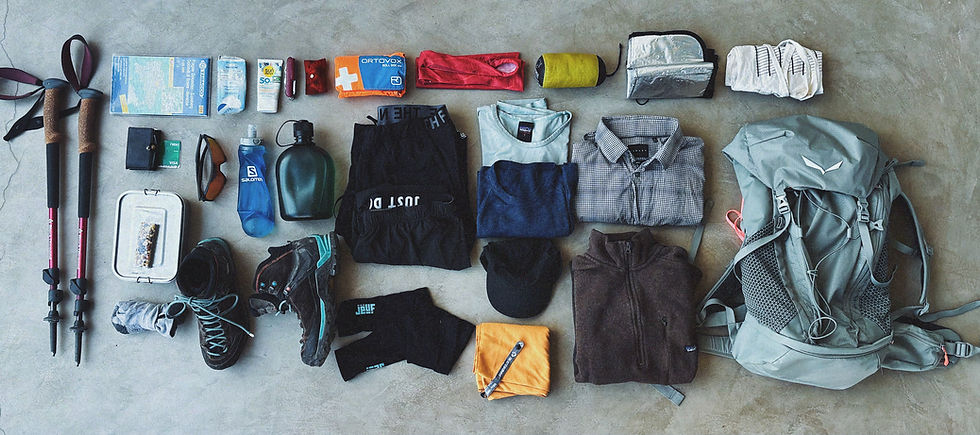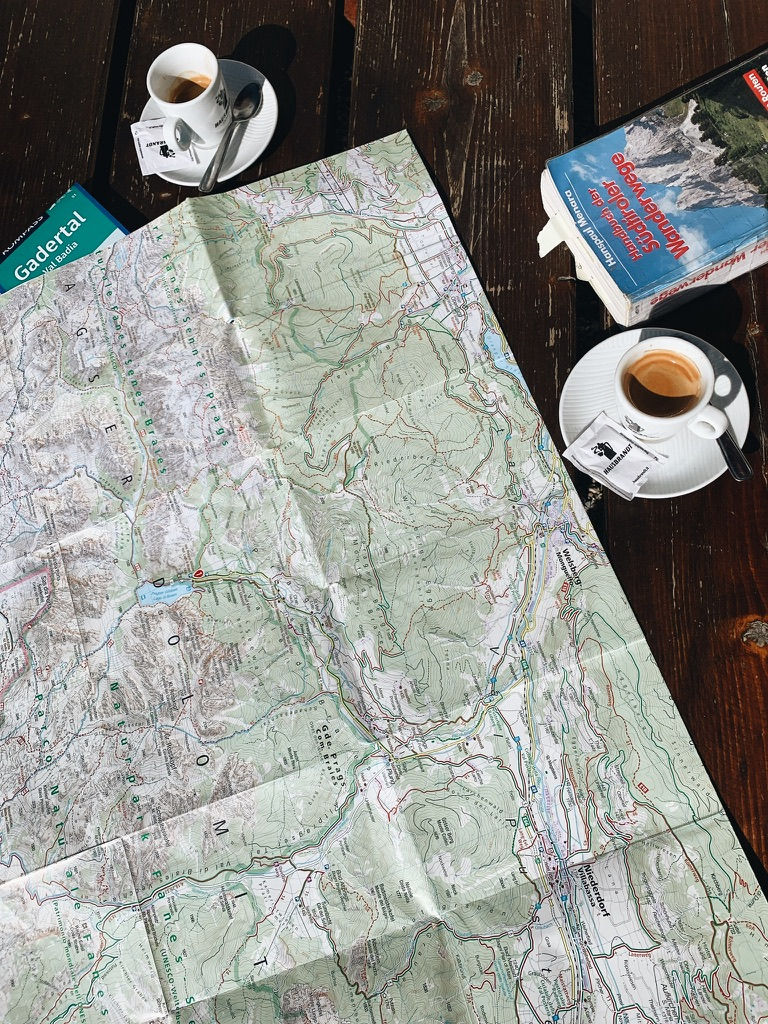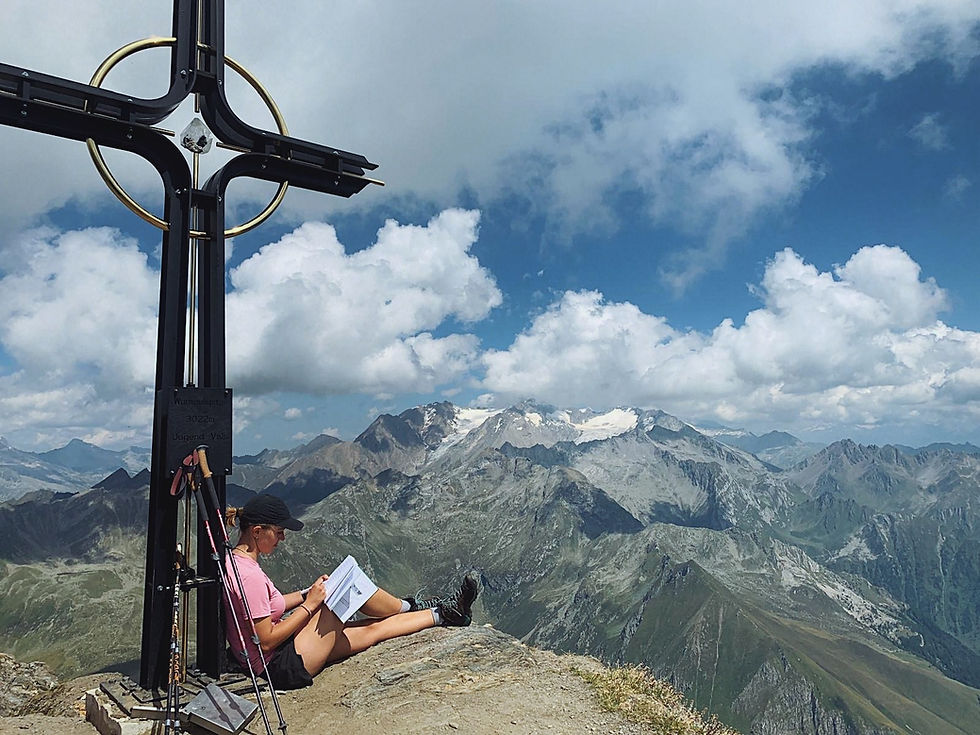The perfect packing list for hiking | What you really need for a day hike
- Laura Haipl

- Aug 14
- 12 min read
Updated: Aug 22
Step out of everyday life and breathe in the fresh mountain air. Whether it’s a summit hike or a high-altitude trail – to fully enjoy the mountains, you need the right preparation. Here is my tried-and-tested packing list for day hikes in the mountains, suitable for spring, summer, and early autumn.
I grew up in the mountains. Even today, when I hike, I feel how much the mountains nourish my inner balance – with their calm, vastness, and stability. On the trail, everything inside me becomes still. The feeling of seeing the world from above and leaving everyday life behind is unique.
To fully immerse myself in these moments, I only bring what I truly need. Over the years, I’ve developed my personal, mindful day hike packing list. It’s as light as possible and well-prepared for various mountain situations. You can use it as a reference for your own day hikes in spring, summer, and early autumn.
TABLE OF CONTENTS

The tried-and-tested packing list for a day hike
Carrying – The right backpack
A daypack of 20–30 liters is enough for most hikes. Comfort is key.
There are two main types of backpack suspension systems:
Aircomfort system: A net separates the pack from your back, allowing airflow. Less weight distribution, more ventilation.
Back-contact system: Padded areas directly contact your back. Better stability, less ventilation.
It is important that the backpack fits your body size and shape well when carrying heavy loads and that you feel comfortable wearing it. It should sit well above your hips and the load should not be carried by the straps, but distributed across your back and hips. In addition, hip and chest straps help to distribute the load evenly across your entire upper body.
Other features to look for:
Padded, wide shoulder straps and hip belts (some with small side pockets)
Adjustable straps
Multiple inner and outer pockets for organization (e.g., side pockets large enough for a water bottle)
Quick, organized access to items in your backpack
Rain cover, usually integrated into the bottom of the backpack
Lightweight: no more than 0.6–1.5 kg when empty (e.g., avoid leather)
robust, durable, water-repellent, and washable material
Walking – The right hiking shoes
Good hiking boots are essential for a safe and enjoyable hike – whether you’re taking a gentle walk or tackling steep terrain. No other item affects comfort and safety as much as the grip and support of your footwear. Time and again, I see tourists in the Alpine region of South Tyrol hiking in sneakers or light, simple running shoes on rocky, sometimes steep terrain, and I want to say to you: please do better! It is really dangerous to hike in the Alps with poor footwear, especially if your feet are not used to this type of terrain or if the ground is wet.
I have learned to always wear high, sturdy shoes – whether I’m tackling a challenging hike or just a small loop along the forest path to the hut.
Good hiking boots not only support my feet – they relieve and stabilize the entire body. They should also provide you with:
Stability, because they are made of firm material and can be tightly adjusted to the foot with laces.
Secure footing, because the foot fits well in the boot but the toes still have freedom of movement, and the sole has good grip.
Protection for bones and joints, e.g., against sharp rocks or ankle twists, as they rise above the ankle.
Weather protection, thanks to water-resistant materials like Gore-Tex, useful when crossing wet grass, streams, or encountering rain.
Prevention of blisters, pressure points, or knee pain, because a well-fitting shoe supports natural movement and prevents overuse injuries.
A good mix of support, protection, flexibility, and weight.
The type of footwear I describe can be classified as category B/C: "Hiking/Trekking boots." Test what fits your foot best, which material feels comfortable (again, like the backpack, I recommend no leather), and where you have the best support. This investment may not be small, but it lasts for a long time.
Tip: If your sole is worn out but the rest of the boot is still in good condition, which happens after countless hikes after about 2 years, many sports stores allow you to replace just the sole for about ¼ or ⅓ of the original price.
Do not forget the right hiking socks. I recommend those made of merino wool or synthetic functional material. They regulate moisture, prevent friction, and keep feet comfortably warm or cool even during temperature changes.
Clothing – Adapt to the weather
The weather in the mountains changes quickly with altitude and can turn unexpectedly. That’s why I wear hiking clothes using the layering principle. Several light layers keep me flexible:
Base layer shirt, sleeveless and snug: Warms the lower back and hip area, where I sweat a lot – especially during cooler parts of the day. Material: functional fabric (no cotton), as it absorbs sweat well.
T-shirt, short or long-sleeved – depending on temperature: For long sleeves, Merino wool is perfect; it keeps you warm, barely absorbs odors, and dries quickly. For a short-sleeved T-shirt, I recommend functional fabric.
Tip: At the summit or resting spot, I change my sweaty short T-shirt and put on the dry long-sleeve Merino shirt while the short T-shirt dries in the sun or wind. On the descent, when I warm up again, I can switch back. This helps prevent getting cold.
another Tip: From cycling, I adopted arm sleeves. Arm sleeves are an extension of a short-sleeve shirt. The advantage: they are super warm, light, and compact, and above all practical when you don’t want to change between the short- and long-sleeve T-shirt and you’re not exactly sure whether it’s cold, warm, windy, or sunny. They can be pulled on quickly and easily.
Light cotton mountain shirt, long-sleeved and button-up: As a practical intermediate layer, it provides light warmth, can be rolled up, protects the collar from the sun, and takes up hardly any space. A piece I learned from the older mountain generation before functional sportswear existed – and I still consider it indispensable.
Hiking pants, short or long depending on temperature: Should not be too tight and allow enough freedom of movement. Many functional pants have lots of pockets and detachable legs, which is very practical. For short pants, I take a thin pair of long pants or merino leggings to put on over them (especially for the summit and rest spots).
Fleece jacket or light wool sweater with hood: For cooler sections, shady breaks, or windy summits. A hood provides extra protection against the wind.
Rain jacket or poncho: I always carry a poncho; the jacket only if there’s a chance of rain.
Headgear depending on the weather: Cap and/or hat depending on altitude and temperature, protects against sun, wind, and cold.
Multifunctional scarf / buff: A real all-rounder – usable as neck scarf, headband, hat, or sun protection for the neck. Can even serve as a face mask for dust, pollen, or sudden cold wind, as a makeshift hairband for long hair, or in emergencies as a first-aid cloth.
Energize – Light, nutritious & uncomplicated
When hiking, I like to be as independent as possible – both from mountain huts and water sources along the way. Of course, a hut can be the goal of the hike, but: hunger often comes earlier than expected, the thunderstorm perhaps faster than anticipated – or the desire to keep going strikes. That’s why you shouldn’t skimp on provisions! What I never leave behind in my backpack:
2–3 liters of water depending on the length of the hike and temperature: In heat, on steep ascents, and with weight on your back, there is nothing worse than too little water. Even if bottles are heavy, take enough and check beforehand whether water is available in streams along your route. Use a lightweight bottle.
Tip: If you drive to the starting point, take an extra bottle for before and after the hike. If you drink enough in the morning, you’ll need less water on the trail, and when you return, you’ll be glad for it.
Another tip: A bit of fresh lemon or elderflower syrup in one bottle is refreshing, slightly sweet, and gives a quick energy boost.
Small energy snack: Nuts, dried fruits, bars, a piece of chocolate, or dates – ideally natural ingredients, without much sugar or additives.
Something savory: e.g., a sandwich with cheese, hummus, or cut vegetables and fruit (cucumber, celery, tomatoes, carrots, apple). A hard-boiled egg wrapped in a piece of kitchen paper, storing a bit of salt with it, is very nourishing together with a sandwich. Avoid delicate foods like avocado or banana.
Quick energy: Glucose tablets for a fast boost or emergencies. I store glucose tablets in the side outer pocket of my backpack, so I have quick access whenever I need them, in case of weakness, thirst, etc. They are light, space-saving, and immediately effective when the body needs glucose fast.
Of course, your food depends on whether you plan to stop at a hut – then you might not need a sandwich. Personally, I love to enjoy my food where it tastes best: at the summit, with a panoramic view, or on a quiet grassy slope, alone, accompanied only by the buzzing insects. A simple sandwich in that moment – pure enjoyment. Often also a small motivation for the ascent.

Details – What you only notice when it’s missing
I always take these things with me – they weigh very little, but when they're not there, you notice it, and they help enormously:
Sunscreen: In a small amount with a high SPF.
Sunglasses: Ones that don’t slip and fit well.
Small first aid kit with blister plasters, tape, and personal (emergency) medication (e.g., wasp sting, pollen allergy, pain etc.)
Pocket knife: an all-rounder, and even if you only use it to cut a mushroom you find, or to share an apple.
Tissues/wet wipe: “wet wipe wonder” as also well described in the packing list for wild camping, a little miracle – for washing hands, cleaning, or refreshing.
Small trash bag/pouch: usable for trash you produce yourself, find in nature, or if you collect mushrooms, herbs, berries, or similar along the way.
ID, health insurance card, some cash: Held compactly together with a rubber band, that’s completely enough. The big wallet stays at home.
Paper map or navigation app (e.g., Komoot) with offline hiking maps.
Towel + swim gear: Maybe you come across a mountain lake and want to refresh yourself. Bikini and small microfiber towel I almost always carry for this reason. Swimming in the mountains with a view is something I can’t resist.
Thin gloves: Light, easy-to-pack gloves are often worth their weight in gold in wind or cool breaks, or on descents where you need your hands.
Rounding Off – What makes your hike even better
Not absolutely necessary – but for me, often the small difference between good and just right. I take these things with me when I want a little more comfort or support on the go:
Seat pad or small sleeping mat: If the ground is wet and/or cold, I really appreciate an insulating seat mat. Alternatively, you can use a piece of clothing – but that often gets dirty or damp. I don’t always need it myself, but I see many hikers who rightly use it regularly.
Trekking poles: Especially helpful on the descent – they relieve your knees, provide extra stability on rocky or slippery terrain, and can be folded small and attached to the outside of the backpack if needed. For me, a game-changer, even if they might not look that cool.
General tips for your day hike
Not everything that matters and makes for a good, relaxing hike in the mountains fits in your backpack—but there are a few things to keep in mind before you set off. Here are my general tips to help you focus on what really matters when you're out and about: feeling nature, being in the moment, and feeling well prepared.
1. Hiking alone? Only with experience
Some hikers love being alone in the mountains, in peace, clarity, fully with themselves. Solo hikes are only sensible if you have a lot of experience and knowledge about the hiking area, navigation, weather, and injuries. Hiking with a partner is not only safer but also allows you to share the path and the view. If you hike alone: choose familiar routes, inform someone about your tour, and save offline maps on your phone.
2. Choose and plan your tour carefully
Not every route suits every day or every person. Make sure that distance, elevation, and terrain match your current fitness and skill level. A hike that overwhelms you endangers not only yourself but also others. Check the length in kilometers relative to the elevation, trail conditions, available rest stops, and how to get there. Often, locals in the mountains know best and can give personal insights and recommendations compared to apps or websites.

3. Start early in the morning
I prefer to start early. In the early hours, the air is fresher, the trail is often empty, the parking lot too, and you have some flexibility if you want to take more time along the way. Also, during the day, depending on the weather and the mountain region, it can become very sunny and hot. Plan to do the ascent and elevation gain in the cooler part of the day. Additionally, in the mountains, thunderstorms often occur in the afternoon, so you should be back in the valley by then.
4. Keep a steady pace
You don’t have to prove anything to anyone. Walk at your own pace, not in the rhythm of others, and above all, keep a steady pace. Frequent short breaks out of exhaustion are tempting, but in the long run, they cost a lot of energy and make you tired. So walk slowly and take few, but slightly longer breaks. It’s not about reaching your destination as fast as possible, but about enjoying the walk and the path.
5. Check the weather before and during your hike
Inform yourself the day before about the weather conditions and get current information about the route. Only set out if the conditions are right. And while on the trail: keep your eyes open, clouds, wind, and temperature can change quickly. Those who notice early can turn back in time. Also, check in advance how to behave in case of a thunderstorm.
6. Phone on airplane mode
In most mountain regions, there is no cell signal. The smartphone constantly searches for a network, unnecessarily draining the battery. That’s why I put my phone on airplane mode and only use it for photos, emergencies, or navigation with offline maps. Know the local emergency number! Also, the silence in the mountains is easier to appreciate without a phone.
7. The journey is the destination
The moment counts. On the trail, I always take time to pause: to enjoy the view, to feel the valley below, to feel the wind on my face, and to see how small you are compared to the massive mountain.
8. Sign the summit book
Signing the summit or mountain hut logbook is more than just a nice ritual – it can be crucial in an emergency. Write down your name, hometown, date, time, and next destination. This way, mountain rescue can trace your route and help faster in case of emergency. It’s also a nice thing if your friends or even yourself can read it after some time.

9. Hike responsibly
I leave no trash behind, but sometimes I take some with me if I find any. I don’t pick protected plants and always stay on the trail. I also greet other hikers – a simple smile is often enough. If the trail isn’t wide enough for ascending and descending hikers to pass each other, those coming from above, the descending hikers, stop to let the ascending ones pass. I also make sure not to dislodge any rocks that could roll down the slope and potentially injure hikers below.
So, what now? Pack your backpack, lace up your hiking boots, and head up the mountain?
With this packing list, you are well prepared for a day in the mountains – whether your goal is a hut, the summit, or simply immersing yourself in the quiet of nature. Of course, even with the best preparation, things can sometimes turn out differently than expected. Maybe your shoe pinches, the weather changes faster than anticipated, or you realize along the way that you actually want to go somewhere completely different.
But often, these are the most beautiful learning moments. The mountains are not just a place for movement – they are also a mirror, a teacher, and a reminder of what truly matters.
If being outdoors in the mountains still isn’t enough for you and wild camping calls, here are some tips and a Packing list for wild camping and sleeping outdoors without a tent. Or maybe you'll combine both in the mountains?
Connect with your outer and inner nature at one of my events and retreats or dive deeper in a 1:1 guidance.
(c) all photos by Laura Haipl





































